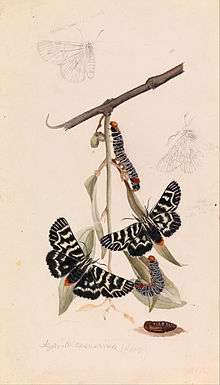Comocrus behri
Comocrus behri, the mistletoe moth, is a moth in the family Noctuidae first described by George French Angas in 1847. It is widely distributed in southern Australia from Perth to Melbourne and adjacent to Bass Strait, occurring as far north as Derby, Western Australia, and Clermont and Rockhampton in Queensland. It may be seen during daylight hours hovering around mistletoe species such as Amyema miquelii, Amyema melaleucae and Amyema cambadgei growing on Casuarina and Eucalyptus trees. The adult moths feed on Eucalyptus flower nectar,[2] have a wingspan of some 58 millimetres and are basically black with white bands running through the wings. Males exhibit 'hill-topping' behaviour, flying to high points in the landscape and there encountering females ready for mating.[3]
| Comocrus behri | |
|---|---|
 | |
| Watercolour by Arthur Bartholomew, 1857 | |
| Scientific classification | |
| Kingdom: | |
| Phylum: | |
| Class: | |
| Order: | |
| Family: | |
| Genus: | Comocrus Jordan in Rothschild & Jordan, 1896[1] |
| Species: | C. behri |
| Binomial name | |
| Comocrus behri (Angas, 1847) | |
Synonyms
- Agarista casuarinae Scott, 1864
- Agarista flexuosa Walker, 1865
- Agarista contorta Walker, 1865
- Agarista cortortus Jordan, 1896
- Agarista casuarina Jordan, 1912
- Agarista cortutus Nye, 1975[4]
References
- Savela, Markku (15 October 2005). "Comocrus Jordan in Rothschild & Jordan, 1896". Lepidoptera and Some Other Life Forms. Retrieved 19 April 2020.
- Mistletoe Moth | Strathbogie Ranges – Nature View
- Noctuids, Cutworms, Armyworms or Semi-Loopers
- Comocrus behri: Mistletoe Moth | Atlas of Living Australia